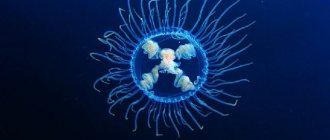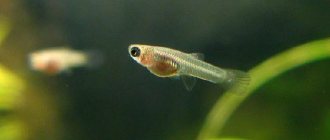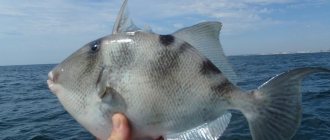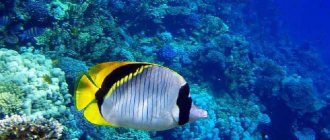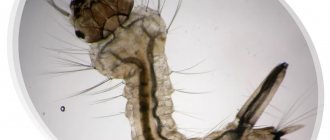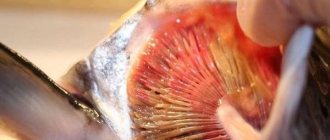How do fish reproduce?
There are monogamous and polygamous, responsible parents and caviar-eating pets.
Sexual method
Sexual reproduction predominates in aquarium fish. Methods for fertilizing eggs:
- Interior. Insemination occurs in the body. Characteristic for viviparous women.
- Outer. The eggs are fertilized in the pond. Refers to spawn-laying.
Depending on the development of eggs, there are three types:
- Viviparous. Development and gestation occurs inside the mother. The embryos feed directly from the mother's body. Breeding is easy due to the high survival rate of the offspring.
- Ovoviviparous. The fertilized eggs are attached to the posterior part of the oviduct. Difference from viviparity - the offspring are separated from the mother's metabolism, nutrition occurs from the contents of the yolk. The mother's body serves only to protect against external threats.
- Egg-laying (oviparous). Deposition of eggs in water.
Parthenogenesis
Parthenogenesis means the development of eggs without fertilization by a male. Rarely found in aquarium conditions. From the eggs, male and female individuals emerge, which over time regulates the numerical ratio of the sexes. This type of reproduction occurs in cyprinids, as well as commercial fish. Unfertilized eggs are adjacent to fertilized ones. Viable offspring rarely appear. Parthenogenesis is a sexual method of reproduction, since germ cells are involved, but gamete fusion does not occur.
Gynogenesis
Males and females of different species participate. As with parthenogenesis, the eggs are not fertilized. The male activates the spawning process. Offspring are born only female.
Hermaphroditism
The presence of male and female characteristics, manifested sequentially or simultaneously. Hermaphroditism includes changing sex during life or laying eggs and fertilization by one fish.
Angelfish have laid eggs: what to do?
The first two days after spawning, parents protect the future offspring, driving away uninvited guests from them. They improve water circulation by fanning the eggs with their dorsal and pectoral fins, and carefully clean the rows of balls, pecking off the whitened dead samples. By this, the fish prevent damage to neighboring eggs.
After a couple of days, the larvae begin to hatch. It looks like this: thin movable tails appear from the angelfish eggs, resembling transparent threads.
During this period, a pair of parents carefully transfers the moving eggs with their mouths to a neighboring leaf. Thanks to their innate instinct, they protect their offspring from death, because proximity to deteriorating empty shells is very harmful.
The development of the larvae continues for another 7–12 days, during which time the supply of nutrients in the yolk sac runs out and, finally, fry from the angelfish eggs appear.
A pair of parents protect and care for their offspring until the small fish begin to feed on their own.
Types of fish
Viviparous
The fish are unpretentious and hardy, and can be easily bred by aquarists. To start spawning, there is no need for frequent water changes and changes in diet - the reproduction process begins by itself. The offspring are completely independent. Viviparous animals lack parental instincts. This group included:
- guppy;
- swordtails;
- mollies;
- platies;
- Gambusia;
- four-eyed fish;
- Formosa.
Spawn-marking
Females lay eggs, and males fertilize them. Fish have learned to hide their offspring from others under plant leaves, in rocks and caves, and in shells.
Spawning
The reason is still not clear, but angelfish prefer to spawn in the evening, closer to night. The female lays a series of eggs on a selected and thoroughly cleaned leaf or object. It swims away a little, giving way to the male, who fertilizes the eggs. Then they change places again, and so on several times. These coordinated movements resemble an underwater dance.
Spawning can last from forty minutes to one and a half hours, during which time the female will lay more than 500 eggs. In an adult large individual, the number of eggs can exceed a thousand. And the male will be nearby all the time.
Angelfish eggs look like small transparent grains that thickly cover a leaf or glass of an aquarium. In fact, the yolk sac of this tiny ball contains enough nutrients for the birth of a full-fledged small fish.
Onset of puberty
Development happens:
- direct;
- indirect.
Direct is characterized by a similar structure of fry and adult fish. Indirect development occurs with transformations: the born individual does not resemble its parents. Those that lay eggs are characterized by an indirect type of development.
To have a similar structure to adult individuals, the offspring go through several stages:
- An embryo is formed inside the egg.
- After passing through the embryonic stage of development, the future fry enters the larval stage. It begins with a rupture of the egg membrane. The larva has large eyes and an elongated body without fins. In the first few days the larva is motionless.
- The whitebait visually resembles a smaller copy of an adult fish. Scales and fins appear.
- Gradually the fry grows to adulthood.
Viviparous species produce independent and structurally similar offspring - fry. This is a direct development.
Fish with a short life cycle become ready to reproduce earlier. Already at the age of 2 months, the fish is ready to reproduce. In small cichlids - at 3 months. Large fish with a long lifespan develop by 4-5 years. There are species that mature in 15-30 years. Males reach puberty earlier than females.
Care of offspring
Born fry, as a rule, are left in the tank where they were born. If the fry were hatched in a common aquarium, they are transplanted into a separate container. Young animals need to be fed 4 times a day. Special mixtures for fry, ground dried daphnia and Artemia nauplii are used as feed. The food is evenly distributed over the surface of the water so that it is easy for the fish to reach it.
When raising fry, special attention should be paid to water quality. The filter is used with caution, as juveniles can easily get inside it and die. Cleanliness is maintained by cleaning the bottom with a siphon and changing water. Good aeration is important. As the juveniles grow, they are transferred to a larger tank and, if necessary, sorted by sex and size. It is important to avoid overcrowding and keeping large fish with small ones to avoid cannibalism.
Reproduction of viviparous
Livebearers spawn several times a year without creating special conditions. If spawning does not occur, gradually increase the temperature a couple of degrees. Pregnancy proceeds faster at elevated temperatures, but too warm water will result in non-viable offspring.
During the incubation period, the female's abdomen will grow and become noticeably rounder, and when it becomes more square, place the expectant mother for a quiet birth.
Keep the offspring separate from the adults, otherwise the fry will be eaten.
Prepare a separate aquarium or a special trap for breeding aquarium fish. After two weeks, the first sexual signs appear. Sort the fry by sex: individuals with a dark spot on the abdomen are females.
Angelfish caviar in an aquarium
Fish of this species should not be removed from the general aquarium before spawning. Of course, unless they have large neighbors with a good appetite.
Signs that the pair is preparing to spawn will become noticeable within a few days. They will begin to jealously guard part of the aquarium, driving away all neighbors from there. Usually the male does this, and the female carefully cleans the selected surface.
An inexperienced aquarist can easily miss these signs and only accidentally notice that angelfish have laid eggs in a community aquarium. Having discovered this, you need to observe how the parents behave and how serious the gastronomic interest in caviar is shown by the neighbors.
Reproduction of spawners
Spawners spawn in different ways. Some species form pairs, others form harems or flocks. The spawning tank is prepared in accordance with the characteristics of the producers.
Dispersal of eggs
Dispersal occurs during school spawning. The eggs scatter randomly and fall onto the ground, leaves and stones. Adult fish do not show parental affection and eat the eggs. To protect the eggs, place the soil in the form of balls with a diameter of 1 cm, cover the bottom with a mesh with small cells.
Masonry formation
The pair form a clutch in a secluded place. The eggs are carefully cared for and protected. Place shelters and broad-leaved plants in the spawning aquarium, where it will be convenient to spawn.
Formation of masonry in caves and gorges
This behavior is typical for fish emerging from aggressive habitat conditions. The spawning ground is equipped with shelters made from piles of rocks, large shells and pots.
Immersion of eggs in the ground
Killie fish, coming from shallow reservoirs with muddy bottoms, form temporary pairs. Pay attention to the soil, choose a substrate based on peat or coconut fibers. Once the parents have spawned the eggs, they can be stored for a couple of months in a warm, dry place. This feature is used when sending eggs by mail.
Nest of bubbles
Labyrinthine fish build nests from air bubbles and pieces of plants. Parents form pairs for life and carefully care for the eggs until the fry appear. When decorating a spawning container, place tall and floating plants. It is imperative to have a tight lid in which an air gap is formed.
Herring / Clupea
— Class — Bony fishes / Subclass — Ray-finned fishes / Superorder — Herrings
Spreading
The herring distribution area embraces the North Atlantic Ocean (both European and North American coasts), north to southern Greenland and Finnmarken, south to the Bay of Biscay; the Baltic Sea with its bay (specifically the small variety called herring), Finnmarken and the Murmansk coast and the White Sea (mainly off the western and southern coast); Pacific Ocean.
Herrings vary quite a lot, but the question of the varieties of these fish remains controversial.
Appearance
The body is laterally compressed, with a jagged edge of the belly. Scales are moderate or large, rarely small.
The upper jaw does not protrude beyond the lower jaw. Mouth is moderate. Teeth, if present, are rudimentary and falling out. The dorsal fin is above the ventral ones. The caudal fin is forked.
Structural features
The anadromous fin is of moderate length and has less than 80 rays.
Reproduction
For spawning, herring gather in colossal schools, sometimes so dense that pressure from the lower fish pushes the upper fish out of the water.
The water becomes cloudy, and a pungent odor spreads over a considerable distance. Masses of fertilized eggs fall to the bottom and stick to underwater objects or stick together into clumps. The number of eggs is approximately 20,000-40,000. Their diameter in Baltic herring is usually from 0.92 to 1 mm, in ocean herring from 1 to 1.3 mm. It usually takes about 2 weeks before the eggs hatch, but at high temperatures, development is reduced to several days.
Lifestyle
Apparently the herring spends part of its life at great depths.
Ocean fishing for it in Europe begins annually near the Scottish Isles, where an area of relative shallow water begins, and gradually moves further and further south. Spawning continues throughout the year and occurs in different places at different times. It is often possible to establish two separate main periods for one place; Thus, in the Baltic Sea, spawning occurs before and after summer, in the ocean - before the beginning of winter and at the end of winter.
Large herring spawn at greater depths (up to 128-213 meters), small herring spawn closer to the shore, sometimes at 2 meters depth and often in less salty parts of the sea.
Nutrition
Herring food consists mainly of small crustaceans, especially copepods (lat. Copepoda), but small fish are also found in their stomach. The latest research shows that the approach of herring to the shores, on which the success of coastal fishing entirely depends, is most closely related to the distribution of water with high salinity and temperature.
Number
This genus includes more than 60 species, distributed in the seas of the temperate and hot, and partly cold, zones. Some species are purely marine and never enter fresh waters, others belong to migratory fish and enter rivers to spawn
Peculiarities of reproduction of popular fish
Fish reproduction is accompanied by interesting features:
- Some fish care for their offspring during the egg stage. Then their parental instincts fade away.
- Male cichlids, on the contrary, are overly worried about the offspring and show aggression towards females if they don’t like something in the treatment of the offspring.
- A sharp change in conditions in viviparous fish leads to a change in sex from female to male.
- Discus fish, angelfish and fairy cichlids take a long time to choose a partner for mating and form a pair for life.
Reviews and experiences of aquarists
In most cases, reviews about the process of keeping angelfish and their reproduction are positive. Aquarists point out that the fish are quite unpretentious, demonstrating good survival rate - up to 85-90%.
Parents show interest in their own fish offspring for only 2-3 days.
If breeding was carried out in a common aquarium without first relocating the pair, then the eggs and fry will then need to be moved to a hatchery. This way you will protect the kids from attacks by other fish and, in fact, by their parents. In the process of moving young animals, an important rule should be observed: the eggs should not come into contact with outside air. Even a second of its influence will lead to the death of the eggs. I recommend using a separate clean container, which could be, for example, a glass. Immerse it directly into the spawning tank where the eggs are located. Immediately transfer the liquid with eggs into a prepared container with aeration and filtration! They will die in standing water! Sergey Ivanovich
Reproduction of angelfish in a home aquarium is not a difficult task, although fish do not immediately give birth to fry. Caring for young animals is simple, so even a beginner can do it. Anna G., Ekaterinburg
Problems
- Breed aquarium fish responsibly. Create conditions for future fish in advance. Calculate how much aquarium volume you will need. Often, due to incorrect calculations or too many offspring, fish suffer from overpopulation. When there is not enough space, the fish become aggressive towards each other and experience stress. In an overcrowded tank, the fish grow smaller in size, which leads to subsequent health problems.
- Another problem is that the fry do not survive to the teenage stage. The death of fry is caused by improper selection of food and poor water quality. Remember that there should be no large particles of food in the container with the fry.
- Avoid inbreeding. Population degeneration occurs due to heterosexual offspring not separated in time. The fish look less bright and may have problems with further self-reproduction. The same applies to closely related species (swordtails, mollies, platies).
- If the necessary conditions are created, and the fish do not reproduce or lay infertile eggs, choose another male as the breeder. Most likely, his gonopodium is damaged or he is already old. The lack of offspring is also associated with unsuitable water parameters. If a white coating appears on the eggs, check whether the temperature is suitable for the fish and whether the water is too hard or soft.
Spawning tank
Before you start breeding, you need to create a special space - a spawning area. It is best to set aside a separate aquarium for it, but if this is not possible, then use a fenced-off space in a common tank. Peculiarities:
- space for a couple;
- lack of decorative ornaments or stones;
- good lighting.
A spawning tank for angelfish is a medium-sized aquarium, about half filled. Without soil, with surfaces for masonry, and the necessary equipment: filter, heater, aerator, light.
The spawning container is created in advance. It is necessary both for the safety of the offspring and for the peace of mind of the couple (there is no need to constantly drive away other fish). In the spawning tank, it is advisable to plant vegetation with strong leaves, place a plastic object or a small container - this will serve as a place for laying eggs (in natural conditions, fish look for a flat and dense surface). After mating, the parents take care of the eggs, but in a stressful situation they can eat the eggs, so sometimes the owner takes care of the eggs, and the parents of their spawning fish are evicted into a common aquarium.
The relocated fish will begin to independently prepare a space for laying eggs.
conclusions
Breed fish by learning the intricacies of spawning the desired species. Get down to business if you have free time and sufficient passion. Choose healthy and vibrant individuals as breeders. Remember that not all species breed in domestic waters. Neons, large catfish, discus and some cichlids are difficult to breed.
Previous
FishPrincess of Burundi - a fish with a developed hierarchy
Next
Fish 16 types of koi carp for aquarium
Next lesson
Remember the importance of animals for plants and humans. What animals do you know that are included in the Red Book of Russia? What animals in your area need protection?
Animals are very important for nature and humans.
Animals help plants reproduce and spread to new territories.
For humans, animals are food, helpers, and friends.
The Red Book of Russia includes Amur tigers, Far Eastern and Central Asian leopards, polar bears, stag beetles, swallowtail butterflies, and sterlet fish.
In our region, Elk, Brown Bear, Beaver, Pika, Siberian Crane, Saker Falcon, and Bustard need protection.
